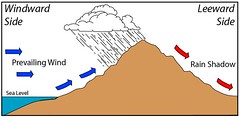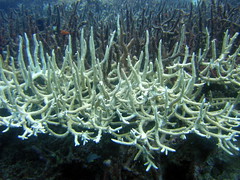APES Friedland Chapter 4 Flashcards
Terms : Hide Images [1]
| 9679601661 | climate | the average weather that occurs in a given region over a long period of time |  | 0 |
| 9679601702 | weather | the short term conditions of the atmosphere in a local area, which include temperature, humidity, clouds, precipitation, and wind speed |  | 1 |
| 9679601662 | troposhpere | the layer of the atmosphere closest to Earth's surface, extending approximately 16 km (10 mi) |  | 2 |
| 9679601663 | stratosphere | layer of the atmosphere above the troposphere, extending roughly 16 to 50 km (10-30 miles) above the surface of the Earth |  | 3 |
| 9679601664 | albedo | the percentage of incoming sunlight that is reflected from a surface |  | 4 |
| 9679601665 | saturation point | the maximum amount of water vapor that can be in the air at a given temperature |  | 5 |
| 9679601666 | adiabatic cooling | the process in which the decrease of atmospheric pressure allows rising air to expand in volume and lower it's temperature |  | 6 |
| 9679601667 | adiabatic heating | the process in which the increase of atmospheric pressure allows sinking air to decrease in volume and raise it's temperature |  | 7 |
| 9679601703 | latent heat release | the release of energy when water vapor in the atmosphere condenses into liquid water |  | 8 |
| 9679601704 | atmospheric convection current | global patterns of air movement that are initiated by the unequal heating of the Earth |  | 9 |
| 9679601668 | Hadley Cell | the convection currents that cycle between the equator and 30 degrees N and S |  | 10 |
| 9679601669 | intertropical convergence zone (ITCZ) | the latitude that receives the most intense sunlight, which causes the ascending branches of the two Hadley cells to converge |  | 11 |
| 9679601670 | polar cells | a convection current in the atmosphere, formed by air that rises at 60 degrees N and S and sinks at the poles, 90 N and S | 12 | |
| 9679601705 | ferrell cell | convection current in the atmosphere that lies between Hadley cells and polar cells |  | 13 |
| 9679601671 | Coriolis Effect | the deflection of an objects path due to Earth's rotation |  | 14 |
| 9679601672 | gyres | large-scale patterns of water circulation that moves clockwise in the N Hemisphere and counterclockwise in the S Hemisphere |  | 15 |
| 9679601673 | upwelling | upward movement of ocean water toward the surface as a result of diverging currents |  | 16 |
| 9679601674 | thermohaline circulation | An oceanic circulation pattern that drives the mixing of surface water and deep water |  | 17 |
| 9679601675 | el Nino; ENSO | a reversal of wind and water currents in the South Pacific |  | 18 |
| 9679601676 | rain shadow | a region with dry conditions found on the leeward side of a mountain range as a result of humid winds from the ocean causing precipitation on the windward side |  | 19 |
| 9679601677 | terrestrial biomes | geographic regions that have a particular combination of average annual temperature and annual precipitation and contain distinctive plant growth forms that are adapted to that climate |  | 20 |
| 9679601706 | aquatic biome | an aquatic region characterized by a particular combination of salinity, depth, an water flow |  | 21 |
| 9679601678 | tundra | a biome that is cold and treeless, with low-growing vegetation |  | 22 |
| 9679601679 | permafrost | an impermeable, permanently frozen layer that prevents water from draining and roots from penetrating |  | 23 |
| 9679601680 | boreal forest | a biome; are forests made up primarily of coniferous (cone-bearing) evergreen trees that can tolerate cold winters and short growing seasons |  | 24 |
| 9679601681 | temperate rainforest | a biome; moderate temperatures and high precipitation typify this biome |  | 25 |
| 9679601682 | temperate seasonal forest | a biome; warm summers and cold winters with over 1 m (39 inches) of precipitation annually |  | 26 |
| 9679601683 | shrubland; Chaparral | a biome; is characterized by hot, dry summers and mild, rainy winters |  | 27 |
| 9679601684 | Temperate Grassland/cold desert | a biome; cold, harsh winters and hot, dry summers characterize this biome |  | 28 |
| 9679601685 | Tropical Rainforest | a biome; are warm and wet, with little seasonal temperature variation |  | 29 |
| 9679601686 | Tropical Seasonal Forests; Savannahs | a biome; are marked by warm temperatures and distinct wet and dry seasons |  | 30 |
| 9679601687 | Subtropical Desets | a biome; also known as hot deserts; hot temperatures, extremely dry conditions, and sparse vegetation prevail | 31 | |
| 9679601688 | Littoral Zone | is the shallow area of soil and water near the shore where algae and emergent plants such as cattails grow |  | 32 |
| 9679601689 | Limnetic Zone | a zone of open water in lakes in ponds |  | 33 |
| 9679601690 | Phytoplankton | floating algae |  | 34 |
| 9679601691 | Profundal Zone | region of water where sunlight does not reach, below the limnetic zone in very deep lakes |  | 35 |
| 9679601692 | Benthic Zone | the muddy bottom of a lake, pond, or ocean |  | 36 |
| 9679601707 | oligotrophic | describes a lake with a low level of productivity |  | 37 |
| 9679601708 | mesotrophic | describes a lake with a moderate level of productivity | 38 | |
| 9679601709 | eutrophic | describes a lake with a high level of productivity |  | 39 |
| 9679601693 | Freshwater Wetland | a biome; aquatic biomes that are submerged or saturated by water for at least part of each year, but shallow enough to support emergent vegetation |  | 40 |
| 9679601694 | Salt Marsh | a biome; a marsh containing nonwoody emergent vegetation, found along the coast in temperate climates |  | 41 |
| 9679601695 | Mangrove Swamps | a biome; occur along tropical and subtropical coasts and contains salt-tolerant trees with roots submerged in water |  | 42 |
| 9679601696 | Intertidal Zone | the narrow band of coastline between the levels of high tide and low tide |  | 43 |
| 9679601697 | Coral Reefs | a biome; are found in warm, shallow waters beyond the shoreline, represent Earth's most diverse marine biome |  | 44 |
| 9679601698 | Coral Bleaching | a phenomenon in which the algae inside the corals die which soon causes the corals to turn white |  | 45 |
| 9679601710 | open ocean | deep ocean water, located away from the shoreline where sunlight can no longer reach the ocean bottom |  | 46 |
| 9679601699 | Photic Zone | the upper layer of water that receives enough sunlight to allow photosynthesis |  | 47 |
| 9679601700 | Aphotic Zone | the deeper layer of water that lacks sufficient sunlight for photosynthesis |  | 48 |
| 9679601701 | Chemosythesis | process in which bacteria deep in the ocean use the bonds of methane and hydrogen sulfide to generate energy | 49 |
